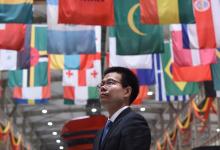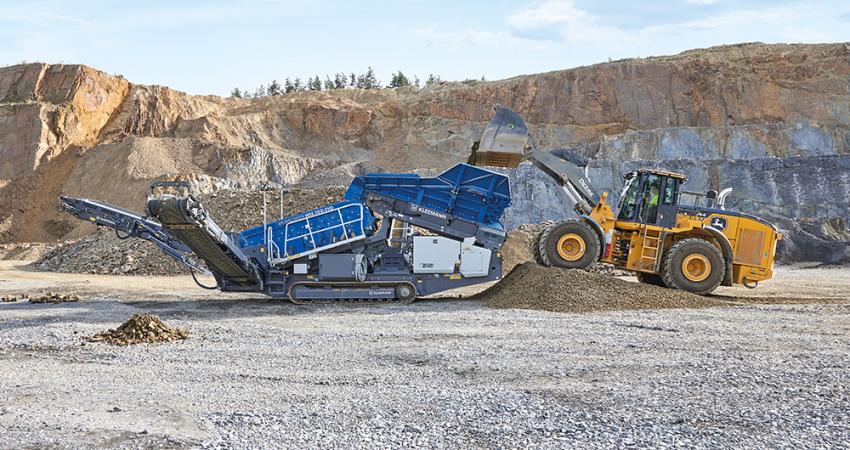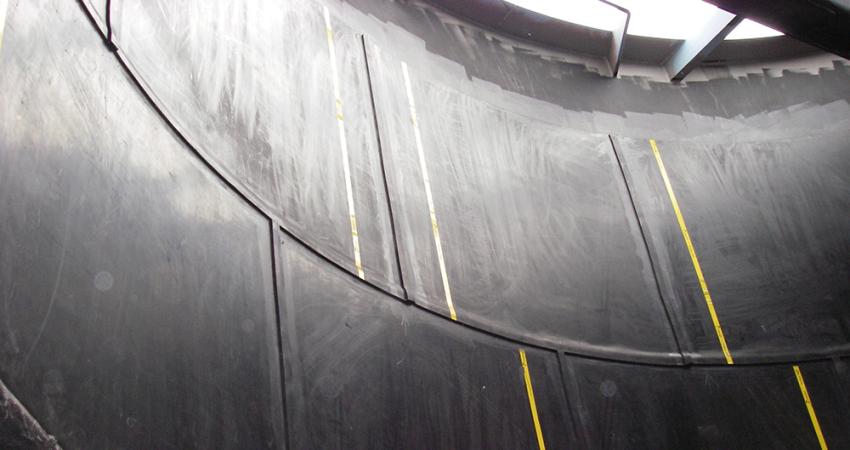
China was the first country to go into a lockdown after being hit by the COVID-19 pandemic in late 2019, but was also the first major economic and industrial power to emerge from restrictive measures.
This has enabled its aggregates and construction equipment sectors to be looking at healthy figures for 2020 at a time when most other nations in the developed world are faced with market contraction.
The pandemic exerted some negative effects on the Chinese aggregates market at the start of 2020 but government measures have helped facilitate a fairly swift return to ‘normal’, according to Zhai Zijian, international trading department manager at Shanghai-based aggregates and quarrying equipment manufacturer SBM.

“Aggregates demand surged in the middle of 2020, because the government put a lot of investment into infrastructure to improve the economy,” Zhai says.
His views are echoed by Chris Sleight of management consultancy Off-Highway Research. Speaking at the online congress held by European construction equipment manufacturers association CECE in October, Sleight described the current global market for equipment such as excavators, loaders and haulers as being “China and everywhere else”.
He added: “The Chinese government has gone very hard on stimulus. The main mechanism of this has been at a provincial level. The central government has allowed provincial governments to issue a lot more bonds, with the stipulation that those bonds have to be spent on infrastructure, agriculture and environmental protection - things which fortunately have a component of equipment sales to them.”
Estimated construction equipment sales in China totalled over 312,000 units in 2019 – the highest level since 2011 - and previously this had been projected to fall by 9% in 2020.
“So instead of the peak [in equipment sales] in China taking a gentle downturn this year, we are seeing quite a spike - a 14% rise is what we think at the moment.”
He added that this projected rise represents “a very, very good level” for the Chinese market, particularly when set against a projected 16% fall in total global equipment sales in 2020.
The Chinese government appears set to maintain the measures that are helping equipment manufacturers for the rest of this year, but it is not clear how long after that the stimulus measures will continue.
The country has been through “a hard time” since the pandemic struck, says David Zhao, editor of China Aggregates Net (CAN), which specialises in independent Chinese aggregates market analysis and statistics.
He adds that China’s COVID-19 pandemic coincided with the Spring Festival, a traditional long holiday when almost all construction and quarries stop working. This year the festival ran from January 24 to February 2.
“During every Spring Festival aggregates production in China will be sharply down, and the pandemic extended that short period to around half month,” says Zhao. He adds that aggregates production in the country began to recover by late February.
“On 1st April, all quarries who report their price to China Aggregates Net had restarted work or were ready to restart, except some quarries in Hubei Province,” Zhao adds.
He says that the Chinese aggregates sector has now fully recovered from the pandemic with the remaining quarries in Hubei Province around the capital Wunan re-opening in April and May.
“The virus itself cannot affect this sector now, but we are ready to deal with any small waves of COVID-19 in the coming winter,” he adds.
To guarantee the necessary raw materials supply for reignition of the country’s economic engine, Zhao says that central and local government have introduced policies to make sure quarries can restart work smoothly, including quicker approving and more strict quality supervision.
China Aggregates Association (CAA) president Hu Youyi said that, after the COVID-19 pandemic, the state has promoted the construction of “two new and one heavy” (‘two new’ equating to new infrastructure and urbanisation construction, and ‘one heavy’ referring to major construction of transport and water conservancy projects).
Hu added that there is a huge demand for aggregates and relevant equipment, aggregates prices continue to rise, and the income of enterprises continues to grow rapidly. Hu said today is the best era for the development of the aggregates industry in China. The central state and local governments have issued many documents to promote the high-quality and healthy development of the aggregates sector.
China’s aggregates industry has entered what Hu described as the “golden era” which is full of opportunities and challenges. More and more players are rushing into the aggregates industry, and there are more and more new, modern large-scale production bases, said Hu.
The CAA says that Chinese aggregates prices are remaining at a generally high level in most parts of the country. Giving figures for September, the association says the selling (ex-factory) price of natural sand (2.3mm-2.8mm) in Shanghai is 95 yuan (€10.93) per tonne, and manufactured sand (2.8-3.3mm) is 92 yuan (€10.58). The price of Dongting Lake sand (2.0mm-2.5mm) in the Yangtze River is 122.5 yuan (€14.09), and the price of manufactured sand (2.8-2.5mm) is 88.5 yuan (€10.18).
The price of crushed stone in Guizhou and Guangxi Province has generally risen. In Guizhou it has increased to 35 yuan (€4.03), while the price of crushed stone (10mm-30mm) in Guangxi has risen to 90 yuan (€10.35).
Crushed stone and manufactured sand prices in Jiangmen, Guangdong Province and Jining, Shandong Province have declined. The price of crushed stone in Jiangmen is 92 yuan (€10.58), while the price in Jining fell to 70 yuan (€8.05). The price of manufactured sand in Jining fell to 75 yuan (€8.63).
The CAA said that the price of aggregates in various parts of China varies greatly due to differences in demand and output.
The levels of post-COVID recovery in the aggregates sector varies by region, according to SBM’s Zhai.
“Some provinces are developing and have many construction projects this year, and the local demand for aggregates and sand will be high,” he says. “On the other hand, some provinces have already undergone development, and there are only small projects. In my opinion this gap will become bigger due to the pandemic, and more investment will take place in developing areas.”
In the first half of 2020 the Chinese government decided to cut tax on companies across all industries by 50% for the rest of the year. Zhai says the government may introduce more measures that benefit enterprise in early 2021.
In terms of which types of aggregates and quarrying equipment are most in demand among Chinese operators, Zhai says it is difficult to make generalisations as the country is so large and each province has different materials, requirements and regulations. He adds that the main unified development trend across the Chinese quarrying sector is towards energy saving and the adoption of an environment-friendly approach.
CAN’s Zhao says that current government policy is leading to increased demand for sand making machines and mobile equipment in the aggregates industry.
“From central and local government to quarries, manufactured sand is now a hot topic in China,” he adds. “China has determined to reclaim abandoned quarries along the most important rivers and city clusters, [so] mobile crushing and screening equipment has a good opportunity.”
An indication that the Chinese market is returning to something like normal was given by the staging of the major bauma CHINA 2020 construction, quarrying and mining machinery exhibition in Shanghai from November 24-27. Organiser Messe München says that more than 2,800 exhibitors attended from 34 countries and regions, despite the COVID-19 crisis and the latest travel restrictions. After four show days the event had been visited by around 80,000 trade delegates.
In spite of the circumstances, bauma CHINA organiser Messe München said the event was able to keep an international flavour and retain 300,000m2 of exhibition space.

“The huge area occupied by international exhibitors such as Caterpillar, Volvo, Bauer, Terex as well as pavilions by Germany, Italy and Spain show the continued international confidence in China’s growth and development,” said Messe München, adding: “In these difficult times, bauma CHINA 2020 gave the entire industry a reason to enter the coming fiscal year with confidence and hope.”
Su Zimeng, chairman of the China Construction Machinery Association, commented: “bauma CHINA 2020 is a very important event for the industry, and it was held when China has achieved major strategic results in COVID-19 prevention and control. The economy is showing a stable recovery. It is also the most successful construction machinery exhibition in the world held this year.”
Bin Qi, regional director - eastern, northern & western China of Terex (Changzhou) Machinery, Shanghai Branch, USA added: “In this special time, the successful opening of bauma CHINA has brought confidence to the industry, manufacturers, investors, and all those who are concerned about the construction machinery industry. The results exceed our expectations, and the visitors are highly professional.”
Thanks to a sophisticated safety and hygiene concept the 10th international edition of bauma CHINA could be held at the Shanghai New International Expo Centre (SNIEC).
Stefan Rummel, MD of Messe München, said he was satisfied with the result: “There is far-reaching demand for innovative technologies, intelligent and low-emission machines, and vehicles with integrated digital solutions. Hand in hand with our partners we therefore made everything possible and provided the industry with a platform even in times of crisis.”
Messe München says that key Chinese accounts such as XCMG, Sany, Zoomlion, Shangdong Lingong, Zhejiang Dingli even increased their exhibition space this year.
“We were able to showcase our high-end machinery and core technologies,” according to an XCMG representative. “And we could meet many new and old customers and make deals.”
Shi Weizhi, deputy general manager of Zoomlion sales marketing company, commented: “In such a difficult situation, taking part in this exhibition allowed us to demonstrate our technological strength and new products to the industry, customers and the public. We will definitely participate in the next edition of bauma CHINA, and even expand our booth.”
In addition to the on-site event, bauma CHINA offered a range of online solutions, especially for international participants who could not travel to China. On the online platform, “bauma CHINA Community”, everyone could virtually participate in bauma CHINA 2020, from their home or office.
The participants could search for exhibitors, exchange company information, get to know products, participate in events digitally and thus gain new market insights. Exhibitors and visitors had the opportunity to communicate via live chats or video conferencing. The organisers say this meant participants were able to generate greater reach and build their social networks in the construction equipment industry.
The bauma CHINA Community is estimated to have had over one million online visitors. Rainer Hirsch, member of the executive board of Herrenknecht said he was impressed by the newly-launched service: “bauma CHINA provided the online platform to build a communication and interaction bridge that breaks the limit of time and space between exhibitors and participants, who are not able to visit the on-site event. The combination of offline and online greatly facilitates communication and helps to achieve cooperation deals.”
The Chinese domestic market in aggregates and other industries can be a difficult place to do business for foreign players, particularly if they lack a good local partner, but CAN’s Zhao says there are opportunities for non-Chinese companies. “Quarries in China now have a relatively longer lifespan and larger productivity, which drives the owner to buy more reliable, long-service-life equipment,” he says. “A well-experienced non-Chinese company can seize that. The challenge for them is that Chinese companies have noticed this trend and are working hard on it.”
The Belt and Road Initiative (BRI) presents ongoing business opportunities for Chinese aggregates equipment manufacturers. The government set up the BRI trade and infrastructure agenda in 2013 and it extends to nearly 70 countries.
SBM’s Zhai Zijian says: “For domestic Chinese aggregates equipment manufacturers the overseas market is huge, and most of countries among the Belt and Road are developing. Aggregates demand is high in those nations. It seems like a win-win business for China and other countries.”
In terms of major developments in the Chinese quarrying and aggregates sector over the next 12 to 18 months, CAN’s David Zhao highlights a trend for state-owned companies buying quarrying rights and taking part in the Chinese construction aggregates industry. In addition, he says that all existing quarries will comply with China’s “green mine” standards by 2022.
As part of its greener quarrying initiative linked to environmental commerce and tourism, the Chinese government has closed tens of thousands of smaller environmentally harmful quarries in the country. This, and a more diligent approach to granting new quarry licences, based on meeting tougher green production and site restoration criteria, has seen the number of Chinese quarries fall by around 40%, from over 300,000 to 180,000.










